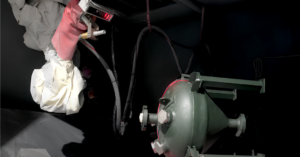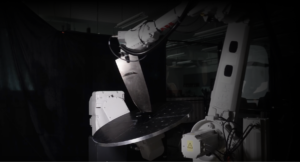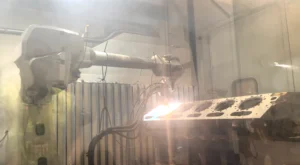table of contents
- Heading 1
- Heading 1
- Heading 1
- Machine Vision System in Robotics Explained:
- How Does A Robotic Vision System Work - The Process:
- What Can You Do With Robotic Vision Systems?
- Top 5 Benefits of a Robotic Vision System:
- 3 Types of Robot Vision Systems:
- 5 Factors to Consider When Choosing a Robotic Vision System:
- Powerful Robotic Vision System by Augmentus:
- Conclusion
- FAQs
share this
Robots can see. Yes, just like how humans see. How do they accomplish this and how do they interact with their surroundings? The concept of robot vision is nothing less than a wonder. Robotic vision technologies use cameras and sensors to help robots interpret and respond to their environment. By mimicking human vision, robots perform complex tasks adaptively with high precision. This blog aims to help you understand the complex theory in the easiest possible way. Let’s get into it.
Machine Vision System in Robotics Explained:
The process of a robot capturing visual data and using it for a purpose is called machine vision. This visual data guides its actions.
The main components include cameras, lighting, and image-processing software. Cameras, the main vision sensor in robotics, capture images of the surroundings, acting like eyes. In some cases, 3D sensors may be used in place of cameras. Sensors provide spatial information instead of images, which can again be used to analyze surrounding information.
Specialized software processes these images to extract meaningful information, more like their brain. This data is then used to make decisions and perform tasks like inspection, measurement, identification, etc.
Machine vision systems are crucial in industrial automation where precision and efficiency are everything. With machine vision, you can identify parts, and product defects, measure dimensions, and read barcodes. And everything within a fraction of a second. By reducing human error and increasing speed, machine vision systems can improve your productivity in manufacturing processes.
How Does A Robotic Vision System Work – The Process:
Understanding how a robotic vision system works can demystify things for you. Let’s take a detailed look at a welding operation for example that uses a sensor-based 3D vision system.
Imagine a factory where robots perform welding tasks with high precision. The process begins with data capture. Sensor-based 3D vision systems are used to gather information. These sensors emit structured light or use time-of-flight technology to capture depth data. This creates a detailed 3-dimensional map of the environment, capturing every surface and object with high precision.
Once the depth data is captured, it undergoes preprocessing. Algorithms process the raw data to filter out noise and enhance clarity. This involves techniques like smoothing, which reduces irregularities, and normalization. This adjusts the data to a consistent scale. The result is a clean and accurate 3D model of the environment.
Next, the system identifies key features within the 3D data using feature extraction algorithms. This includes edges, corners, and specific shapes. These features are crucial for understanding the environment’s structure. For instance, in a welding task, the system might identify the edges of metal sheets or the shape of joints that need to be welded.
After feature extraction, the system performs spatial analysis. This step involves understanding the relationships between different features. For example, the system might calculate the distance between two metal sheets or determine the angle at which they meet. This spatial information is vital for precise welding.
Pattern recognition is the next stage. The system compares the extracted features with a database of known models. Basically, a comparison is done between the desired and the received outcome. This helps in identifying the exact type of joints and understanding their orientation. Machine learning models play a crucial role here. They are trained on vast datasets, allowing the system to recognize various objects and patterns with high accuracy.
Once the joints are identified and their spatial relationships are understood, the system calculates the necessary actions. This information is sent to the robot’s control unit, which guides the robot’s movements. The control unit uses the spatial data to plan the welding path and execute the welds precisely.
The robot’s arm, equipped with a welding end-effector, moves to the identified location. It adjusts its position and angle based on the data received. The welding end-effector performs the actual welding, following the precise path calculated by the vision system.
A robotic vision system can use advanced sensors to capture detailed depth and spatial information. They process this data to create accurate 3D models, extract key features, and perform spatial analysis. This information guides the robot’s actions, enabling precise and efficient welding operations. This process is critical for applications requiring detailed environmental understanding and high precision.
What Can You Do With Robotic Vision Systems?
Robotic vision systems are incredibly versatile and can be used across various industries. Let’s see a few of them in this section:
Manufacturing:
Robots in manufacturing are employed for quality control. These can inspect products on an assembly line, identifying defects or deviations from standards. With this in place, only high-quality products make it to the end of the production line. This means less waste and more efficiency.
Automotive Industry:
In the automotive industry, robotic vision systems are used for tasks like welding, painting, and assembling parts. These systems ensure that each component is placed correctly and meets quality standards. For example, vision guided robots can place car doors accurately during assembly.
Logistics:
Logistics and warehousing also benefit greatly from robotic vision. Vision systems enable robots to sort and categorize packages, optimizing the entire supply chain. Robots can identify and direct packages of different shapes and sizes to the appropriate conveyor belts or storage areas. This streamlined operation reduces the chances of errors.
Healthcare:
Surgical robots equipped with vision systems can perform delicate procedures with unmatched precision. They can identify specific tissues, navigate complex anatomical structures, and make precise incisions.
Agriculture:
In agriculture, robotic vision systems are used for tasks like crop monitoring and harvesting. Robots can identify ripe fruits and vegetables, picking them at the optimal time. This increases yield and reduces human intervention. Vision systems also help in identifying signs of disease or pest infestation early. This can save tons of food items going to waste.
Retail:
Automated checkout systems use vision technology to scan and identify items. This can make the checkout process faster and more efficient. Additionally, robots equipped with vision systems can assist in inventory management by scanning shelves and identifying items that need restocking.
Security:
Robotic vision systems can strengthen monitoring capabilities. Robots can patrol areas, using vision systems to detect intruders, monitor activities, and even recognize faces. This improves security and reduces the need for human patrolling.
The possibilities with robotic vision systems are endless. Innovations will continue to emerge as technology advances. These systems not only enhance precision and efficiency but also open up new avenues for automation, making various industries more productive and safer.
Top 5 Benefits of a Robotic Vision System:
Before diving into the types of robotic vision systems, it’s essential to understand why they matter. Here are some key benefits:
1. Accuracy:
Robots can perform tasks with pinpoint precision. This minimizes errors and proves quality consistently.
2. Efficiency:
Speeds up processes while maintaining high quality. As a result, productivity increases and costs decrease.
3. Improved Safety:
Reduce human involvement in hazardous tasks. This creates a safer working environment.
4. Flexibility:
Robotic vision systems also offer flexibility. They can be reprogrammed for different tasks. This makes them ideal for industries with changing requirements.
5. Better use of humans:
By automating repetitive and dangerous tasks, these systems allow human workers to focus on more complex and creative aspects of their jobs. This enhances overall productivity and job satisfaction.
6. Adaptability:
Robot vision analyzes the current environment and allows the robot to adjust its movements based on feedback. This reduces human intervention in the process.
3 Types of Robot Vision Systems:
You now know the benefits. Let’s talk about the types of robot vision systems. Different tasks require different types of vision systems. Each one is made to serve specific needs:
1. 2D Vision Systems:
These systems work well when objects are on a flat plane. They capture X, Y, and angle data to locate objects. 2D vision is suitable for applications like barcode reading, simple inspections, object sorting, and pick-and-place tasks where height information is not critical. One typically chooses a 2D vision system in a fast-moving production environment where speed can be critical.
There are a few robot vision systems that offer 2.5D vision. This allows the robot vision system to also measure depth, which is exactly what the D in 2.5D stands for.
2. 3D Vision Systems:
These provide X, Y, Z, and rotational data. This allows robots to understand complex environments with varying object orientations. 3D vision is essential for tasks that require depth perception. Examples include bin picking, assembly, and inspection of complex geometries.
3D vision comes in broad ranges. They vary based on accuracy requirements and the environment they are used in.
Some of the most common 3D vision technologies are:
a. Laser Time-of-Flight (ToF):
These provide X, Y, Z, and rotational data. This allows robots to understand complex environments with varying object orientations. 3D vision is essential for tasks that require depth perception. Examples include bin picking, assembly, and inspection of complex geometries.
Laser scanners commonly use ToF, in which an array of laser transmitters and receivers form a line. This allows them to obtain a large array of points quickly. This can be seen in products such as LMI’s GoCator.
b. Laser Phase Shifting:
This method involves high-end sensors and measures distance with very high precision. The laser phase shifting method calculates the phase shift of light waves during pulse emission and reflection. It is usually used to perform close-loop adjustments of a robot where high precision is a necessity like machining operations.
c. Photogrammetry:
Photogrammetry estimates the 3D shape of an object using sophisticated algorithms. It analyzes multiple photographs and extracts 3-dimensional information about the scene. Photogrammetry detects the features of the object using camera position estimation to create a geometrically consistent point cloud. This is one of the cheapest methods of 3D reconstruction and is often used in entry-level scanners.
d. Structured Light + stereo vision:
This system gives the distance of each object from its sensor using structured light scanners. These scanners do this by projecting a series of light patterns onto the object which emphasizes its deformation and shape. Structured light scanners can achieve very high precision with a relatively fast capture speed using an additional camera. Structured light scanners are often used on On-arm and off-arm robotic mounts, and their uses vary from general 3D scanning to pick-and-place and measurements. For quick 3D imaging, brands like MechMind use structured light in the blue-violet spectrum, while Sensors like Structure Sensor use infrared light.
3. Integrated Vision Systems:
Combining 2D and 3D technologies, these systems offer comprehensive solutions for intricate tasks. Integrated systems provide the flexibility to handle a wide range of applications. These range from simple inspections to complex robotic guidance.
Choosing the right type of vision system depends on the specific requirements of your application. 2D systems are cost-effective and suitable for many tasks. Whereas, 3D and integrated systems offer advanced capabilities.
5 Factors to Consider When Choosing a Robotic Vision System:
Selecting the right vision-guided robotics system can be challenging with so many options available. It is important to consider the following five factors:
- Application Needs: Understand the specific requirements of your tasks. Consider factors like the field of view, resolution, type of objects, required precision, and speed.\
- Environmental Conditions: Consider IP rating, lighting, space, and object variations. Ensure that the system can perform reliably under your working conditions. There are other ratings such as explosion rating. This is important too as it determines if the vision system can be deployed without it being damaged.
- System Compatibility: Ensure the vision system integrates seamlessly with existing equipment. Compatibility with current robotic frameworks and software is crucial for smooth operation.
- Budget Constraints: Balance between functionality and cost. Evaluate the return on investment and choose the one that meets your needs without breaking the bank.
Future Scalability: Choose systems that can evolve with your needs. Look for solutions that offer flexibility and can be upgraded or expanded as your requirements grow.
Selecting the right vision system is critical for maximizing the benefits of automation. By considering these factors, you can ensure that your investment delivers long-term value and enhances your operational efficiency.
Powerful Robotic Vision System by Augmentus:
At Augmentus, we offer state-of-the-art robotic vision guided systems tailored to your needs. Our systems are designed for easy integration, high accuracy, and maximum efficiency. Whether it’s 2D or 3D, we have the perfect solution for your automation challenges.
Augmentus’ robotic vision guided systems stand out for their user-friendly interface and robust performance. Our solutions are designed to minimize setup time and provide reliable operation in diverse environments. With advanced features like AI-powered image processing, our systems provide optimal performance for your needs.
Conclusion
Robotic vision systems are revolutionizing the way industries operate. They bring precision, efficiency, and versatility to the game.
This technology has the power to keep you ahead and relevant. Because the future of automation has arrived. Everyone is making their shift to vision guided robotics. If you haven’t yet, it’s your time.
Learn how Augmentus’ advanced robotic vision guided systems can revolutionize your automation processes. Schedule a Demo to learn more and see our offline robot programming software in action!
FAQs
How much does a machine vision system cost?
Pricing can vary based on factors like application needs, system complexity, and features. For precise cost details, contact us directly or schedule a demo with us.
What is the vision system in AI?
A vision system in AI uses cameras and sensors combined with image-processing software to capture, interpret, and respond to visual data. This system mimics human vision, enabling robots to perform tasks like inspection, measurement, and identification with high precision.
How do you give a robot vision?
To give a robot vision, integrate cameras for image capture, proper lighting for clarity, and image-processing software to analyze the images. You can also use a sensor in place of a camera for spatial information instead of images. This can again be used to analyze surrounding information. Use algorithms for edge detection and feature extraction, and send the processed data to the robot’s control unit to guide its movements and actions accurately.
What industries benefit the most from robotic vision systems?
Many industries can benefit from robotic vision systems including manufacturing for quality control, automotive for assembly tasks, logistics for package sorting, healthcare for surgical precision, agriculture for crop monitoring and harvesting, retail for automated checkout and inventory management, and security for enhanced monitoring and facial recognition.
How do robotic vision systems integrate with existing robotic frameworks?
Robotic vision systems integrate with existing frameworks by ensuring compatibility with current equipment and software. This allows for smooth operation and enhances functionality. Considerations like application needs, environmental conditions, and system compatibility are crucial to achieving effective integration and maximizing automation benefits.



